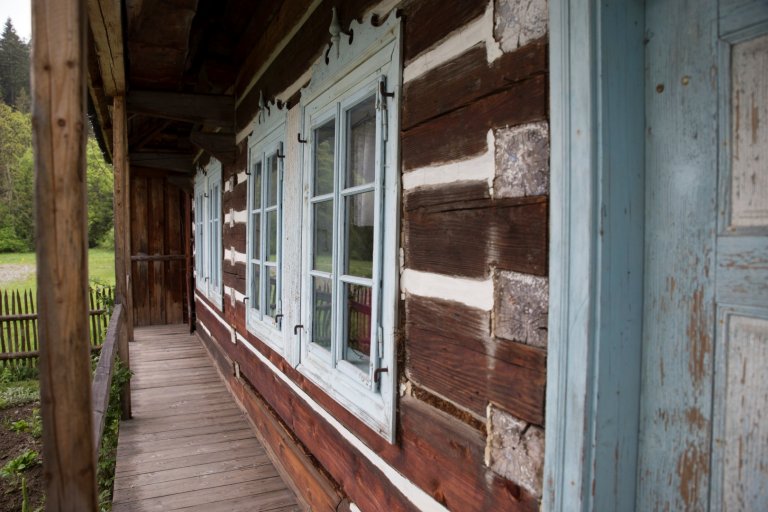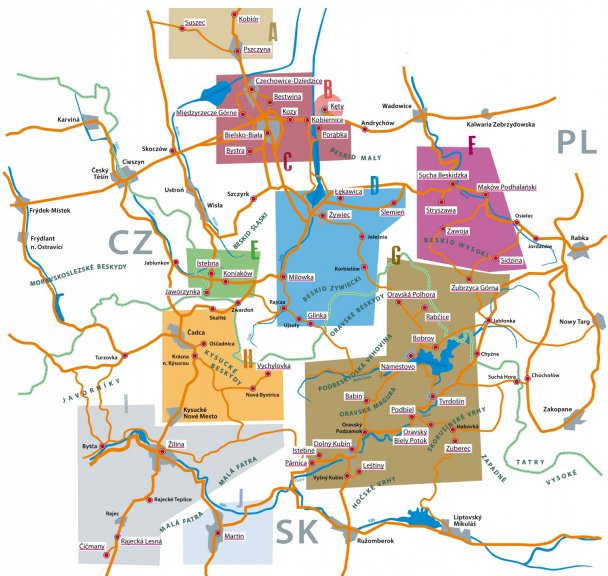Zubrzyca Górna – The Orava Ethnographic Park Museum

80 years ago (1937) the siblings of Joanna Wilczkowa and Sandor Lattyak (Łaciak), The Moniak family’s heirs transferred 4-hectare plot with a mansion and the outbuildings to the Treasury. Their wish was saving the old-fashioned character of this court estate as a museum for the next generations. This was the origin of the Orava Ethnographic Park – the Museum in Zubrzyca Górna. Today it is a 12-hectare area with 60 buildings.
The Museum exhibits housing constructions with their interior design, outbuildings, a garner, a cellar, a bee-yard, a sawmill, a fulling mill, a smithy, a windmill combined with a sawmill (a building representing peasants’ industry in Orava) and an oil mill. There are also two taverns from Podwilk. We can see almost 30 exhibitions portraying the life of the nobles and the peasants from the 18th to the 20th century.
The Moniaks’ croft is a wooden mansion typical for the local construction, it has a shingle hip roof and the smoke holes letting the smoke out from the hearth. The older part housing a white room, a black room, and a pantry is dated from 17th century. In the black room with a clay floor, a lot of activities took place such as cooking, butter making, barley groats making, weaving and even the poultry and rabbits were kept there. The white room (without the smoke) was a place of resting and receiving guests. The floor was wooden there. One of the decorative element is a few level shelf with plates and cups with some glass paintings of saints at the top. In 1784 the second wing was built. The most representative room in the mansion was a living room furnished with Biedermeier and Louis Philippe styles.
In the Paś-Filipek house, we can see a weaving exhibition with accessories and three workshops. In the Dziubek house, we can see a wedding exhibition (table layout, hierarchic guest table seating, costumes). There is also a croft of the poorest peasants dated from the 19th century. In another croft we find typical amenities and there are also a smithy, a ground cellar, a well as well as a vegetable and flower yard and an orchard. In the oil mill we can see how the oil was pressed, in the fulling mill a broadcloth fulling is shown and in the sawmill the old technique of wood processing can be seen. They also have some small architecture objects – fences, bridges, wells, arbours, etc.
The Museum has been organizing classes called “The Museum Educational Trails” since 2001. There is a story called “What’s the story with flax”. The trail called “From the grain to the bread loaf” starts with threshing, then the grains are separated from the chaff on the sieves, later floured in quern-stones and finally, the dough is formed to make flatbread. The trail called “The trail of peasant industry in Orava” shows technical solutions, equipment, and tools needed in the windmill or oil mill.
The Museum in Zubrzyca is a place which offers very attractive ways of spending free time. There are presentations of old instruments, “Carol-singing at the Museum”, numerous workshops, exhibitions (including modern art), meetings and even a Chamber Music Festival. The museum park has also developed over the recent years – the reconstruction of the historic church complex from Tokarnia and rebuilding of the clergy house complex from Podwilk (now there are offices there and meetings and exhibitions are organized as well). An amphitheatre and a playground were built. New projects are constantly carried out. Between 2017 and 2018 new trails are and will be constructed this time connected with plain weave making and dyeing.
Muzeum – Orawski Park Etnograficzny
34-484 Zubrzyca Górna
tel. (+48) 18 28 527 09
e-mail: biuro@orawa.eu, muzeumope@poczta.onet.pl
www.orawa.eu


